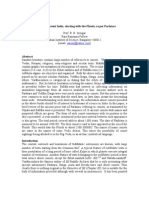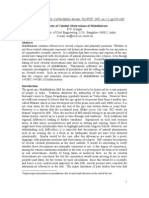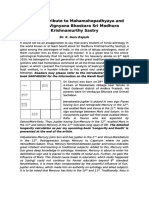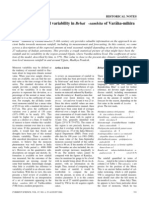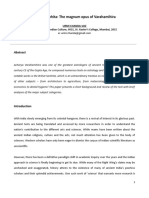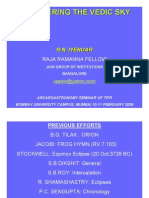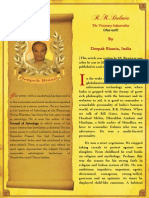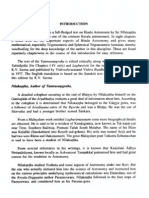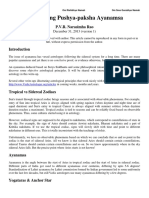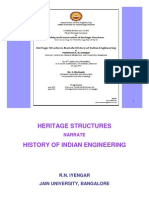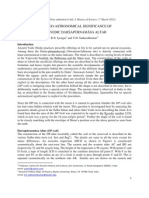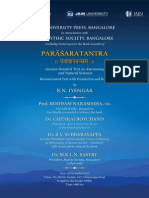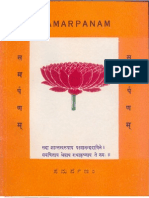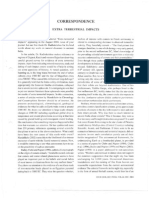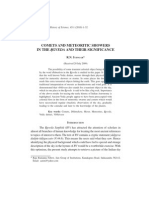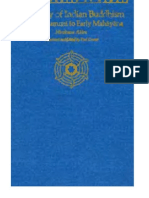Professional Documents
Culture Documents
Dhruva The Ancient Vedic-Hindu Pole Star
Uploaded by
Narayana IyengarOriginal Title
Copyright
Available Formats
Share this document
Did you find this document useful?
Is this content inappropriate?
Report this DocumentCopyright:
Available Formats
Dhruva The Ancient Vedic-Hindu Pole Star
Uploaded by
Narayana IyengarCopyright:
Available Formats
Indian Journal of History of Science, 46.
1 (2011) 23-39
DHRUVA THE ANCIENT INDIAN POLE STAR: FIXITY, ROTATION AND MOVEMENT
R N IYENGAR*
(Received 1 February 2010; revised 24 January 2011) Ancient historical layers of Hindu astronomy are explored in this paper with the help of the Purn as and the Vedic texts. It is found that . Dhruva as described in the Brahmn da and the Visn u purn a was a star .. .. . located at the tail of a celestial animal figure known as the iumra or the Dolphin. This constellation, which can be easily recognized as the modern Draco, is described vividly and accurately in the ancient texts. The body parts of the animal figure are made of fourteen stars, the last four of which including Dhruva on the tail are said to never set. The Taittirya ranyaka . text of the Krsn a-yajurveda school which is more ancient than the above .. . Purn as describes this constellation by the same name and lists fourteen . stars the last among them being named Abhaya, equated with Dhruva, at the tail end of the figure. The accented Vedic text Ekgni-kn da of the .. same school recommends observation of Dhruva the fixed Pole Star during marriages. The above Vedic texts are more ancient than the Grhya-stra . literature which was the basis for indologists to deny the existence of a fixed North Star during the Vedic period. However the various Purn ic and . Vedic textual evidence studied here for the first time, leads to the conclusion that in India for the Yajurvedic people Thuban (-Draconis) was Dhruva the Pole Star c 2800 BC. Key words: Dhruva, Draco, Pole Star, Precession, Purna, iumra, . Taittirya ran yaka, Thuban, Yajurveda .
INTRODUCTION The legend of Dhruva who as a young boy observed long penance to achieve the exalted position of the fixed North Star is a widely known children story in India. The origin of this legend can be traced to the Visnu purna which .. .
* Raja Ramanna Fellow, Jain University, Bangalore-Kanakapura Road, Jakkasandra 562112. e-mail: aareni@yahoo.com
24
INDIAN JOURNAL OF HISTORY OF SCIENCE
describes the story in detail. Dhruva is also important in traditional Hindu marriages when the bride is made to view the Pole Star so that she can be strong and fixed in her new home. At present the curiosity of a child to see Dhruva would be satisfied by pointing the star Polaris (-Ursa Minor)1. This seems natural since the meaning of the word Dhruva as fixed and steadfast is reasonably well matched by Polaris (Fig.1). However the Purn as did not mean the present Pole Star to . be Dhruva in their descriptions. This throws up several interesting questions about the identity of the original Dhruva, the Pole Star referred not only in the Purnas . but also in the Vedic literature. The genre of literature called Purn a in Sanskrit is vast as it is ancient. . There are eighteen major and an equal number of minor texts under this category. It is the usual practice to explain the word Purn a as ancient legends handed . over from generations, whereas Itihsa in contrast meant history. It is surmised that some type of nucleus Purn a should have existed from the Vedic period, . since the Chndogya Upanisad refers to itihsam, purnam as important subjects . . of study. The present day bulky texts are likely the results of repeated additions over time to the original text. This development seems to have happened in different parts of India, since some of the Purnas have strong regional flavour. . Nevertheless, one can easily discern a substratum of cosmology, creation, dissolution, ancient genealogy of kings, sages and vintage astronomy common to all the Purnas. Almost all the Purnas contain historical elements some of which can be . . dated to the early centuries of the Common Era, matching roughly with the Gupta period. When the texts were fixed in writing for the first time newer material valid for the time and place might have been added by the copyists. But what is interesting is that the texts also contain material which by no means can be reconciled with the early centuries of the Common Era. The detailed description of the star Dhruva in the constellation named iumra is a case in point. It is known from modern astronomy that due to precession of the axis of the earth, the North Celestial Pole (NCP) executes a circle in space moving at the rate of nearly one degree in 72 years, such that for an observer on earth the NCP would get associated with different fixed stars in different epochs of time. It is also known that during the early centuries of the Common Era no bright star had occupied the position of NCP. The declination of Polaris in 500 AD was 810. Even though it could represent the northern direction, it attained the position of the Pole Star only after another 1000 years. Thus it is amply clear that the Dhruva
DHRUVA THE ANCIENT INDIAN POLE STAR
25
of the Vedic religion and of the Purna was some star other than -Ursa Minor. . Again it is known from modern astronomy that the star Thuban or -Draconis held the position of the Pole Star for a long period starting from c 3000 BC. This fact was pointed out by Jacobi2 in the 19th century for arguing a date more ancient than 1500 BC, for the Rgveda. He was referring to the Gr hya Stra literature . . which codifies the religious practices including the marriage ritual that is still followed by a section of the Hindu society. These codes prescribe ritualistic observation of Dhruva as a fixed star, but at the late date when they were compiled long after the Vedic canons, there would have been no proper Pole Star to see and develop a law for the orthodox Hindus. Jacobis argument was that the ritual should have originated at a time when -Draconis or Thuban was the fixed star to be called Dhruva by the Vedic people. The argument though logical was opposed by a few influential indologists eventually dismissing the claim of Jacobi without any detailed analysis of available evidences. With this in the background, the present paper takes a fresh look at the identity of the classical Dhruva of Hindu scriptures. The Purnas which describe the legend of Dhruva are considered first. This is followed . by investigating the links, of this legend to the Taittirya ranyaka which preserves . the oldest and clear description of a constellation matching with an animal figure called iumra. This constellation finds mention also in the Pan cavimsa . Brhman a of the Smaveda. . BRAHMNDA PURN A (BR. P) .. . All the Purnas contain the basic story of the young boy Dhruva, who by . his penance got the boon of being fixed in the north as a star. Since the meaning of the word Dhruva which appears several times as early as in the Rgveda is . unequivocally accepted as fixed, certain, unchanging, it is implicit in the Purnic . story, the boy Dhruva was identified with the eponymous Pole Star which was fixed in the north. This fact becomes interesting since all the texts provide cogent information on its observable location in the sky. But quite objectively they also mention the self rotation of Dhruva as the driving force for other celestial bodies to move around the NCP. This theory of Dhruva, not only embeds rudiments of Hindu astronomy but also indicates that the effect of precession had been noticed by the Purnas. It is known that no absolute dates can be put forth for the various . ancient Sanskrit texts. But mention of Dhruva as fixed and then stating that it was also subject to change hints at the possibility of arriving at plausible relative chronology for the particular descriptions. There is a view that the Brahmnda ..
26
INDIAN JOURNAL OF HISTORY OF SCIENCE
was the original out of which the Visnu Purna and the Vyu Purna bifurcated .. . . with further variations3. We consider here the Br. P first and later look at variant information from a few other texts. In the first chapter of Br. P a list of the contents to be covered is provided. This promises some astronomy related to Dhruva as,
srydnm syandannm dhruvdeva pravartanam| krtyante iumrasya yasya pucche dhruvah stithah || (1.84) . . The movement of sun and other celestial bodies is explained as induced from Dhruva, who resides at the tail of the iumra.
This theory is further expounded in chapters 21-24 in considerable detail. We restrict our attention here to statements directly concerning Dhruva.
tatomandataram nbhym cakram bhramati vai tath| mrtpinda iva madhyastho dhruvo bhramati vai tath || . .. trimanmuhrtnevhuh ahortram dhruvo bhraman| . . ubhayorks. hayormadhye bhramate man dalni tu || .t .. kulla cakranbhica yath tatraiva vartate| dhruvastathhi vijn eyastatraiva parivartate|| (Ch 21.v 94, 95,96) Like the lump of clay at the centre of the potters wheel moves slowly sitting at the navel, Dhruva rotates. Dhruva moves in circles day and night consisting of 30 muhrtas in the middle of the two directions (north and south). Like the navel of the potters wheel stays in the same place, so also Dhruva should be known to be rotating there itself.
Chapter 21 containing 176 verses gives an archaic account of suns motion, with definitions of seasons, equinox and solstice. It introduces the cosmography of Mt. Meru connecting the earth and the heaven like a vertical pole in the north, around which all celestial bodies are modeled to move in circular paths. It ends with identifying Visn upada (Visnus place or foot) in the north above the Seven .. .. Sages (U.Major) wherein Dhruva, Dharma and others are located. The next chapter starts by defining the position of Dhruva as
bhtasammohanam hyetadvadato me nibodhata | pratyksamapi dryam ca sammohayati yatprajh || . . . yoyam caturdiam pucche aiumre vyavasthitah | . uttnapdaputrosau medhbhto dhruvo divi|| .
DHRUVA THE ANCIENT INDIAN POLE STAR
27
sa vai bhrmayate nityam candrdityau grahaih saha | . bhramantamanugacchanti naksatrn i ca cakravat || (Ch 22. v5, 6,7) . . Listen to this (explanation of mine) which is real and observable but mystifying people. He, who is at the tail of the (constellation) looking like a iumra; Dhruva the son of Uttnapda, has become the main pivot of the pole in the sky. Verily, he rotates the sun, the moon and the planets continuously. The stars follow him who is himself moving like a wheel.
In the above the narrator (Sta) is explaining a real observation of the sky to explain the ancient theory of Dhruva as controlling the celestials and their motion. The phrase caturdiam pucche appears in some texts but the Matsya Purn a has the correct word caturdaarksesu, meaning among the 14 stars. . . . . The word aiumra is a derivative of iumra. Hence this word would mean like imra. Since Dhruva as a north star is said to be at the tail of this figure, iumra should be a constellation in the northern sky. The text further elaborates the self circling motion of Dhruva and that of the stars (trh) and the naksatras . . around him. The point to be noted is the differentiation between the general stars and the naksatras. The latter are the 27 ecliptic asterisms or star groups and . Dhruva was never one among them. There are 84 verses in this chapter, much of which is devoted to develop a physical model for the motion of Sun seen in the day linked to Dhruva seen only in the night. The northern and southern sojourn of Sun also had to be explained within this model. The details need not concern us here other than noting that Suns chariot is said to have only one wheel, the axle of which is connected to the axle in Dhruva by two strings of light which take care of the change in the orbit of Sun around the earth. We may speculate that the analogy of the potters wheel was unable to mimic the observed motion of the sun and hence the double axle model and connection to Dhruva with unseen strings was proposed to simulate action at a distance. This change is also seen in the example of the oil mill (taila-pd cakra) known colloquially as ghni, with . . a locally spinning central pole, proposed as another model for understanding the motion of the stars around Dhruva. The next chapter is important to the history of Indian astronomy as it explains the lunar number 3339, first appearing in the Rgveda. This number is presented as the count of deities approaching Moon to . drink his essence (soma-pna) every night sequentially in the dark fortnights. This naturalistic number has been demonstrated to be the 18-year eclipse period number by the present author4. There are other interesting statements such as Dhanis.th (-Delphini) being the first among the naksatras, along with the names . .
28
INDIAN JOURNAL OF HISTORY OF SCIENCE
. of the five year cycle of the Vednga Jyotisa. Towards the end of the chapter . the text describes the location of Dhruva along with other near by stars making up the animal figure iumra.
evam dhruva-nibaddhosau sarpaate jyotisngan ah | . . . saisa trmayah proktah iumro dhruvo divi || . . . skrah iumraca vijn eyah pravibhgaah | (Ch 23.v 99, 101b) . . . In this fashion all the celestial bodies move being bound to Dhruva. In the sky he is (in) the starry iumra. This iumra should be known by its shape and divisions.
The chapter ends with a good description of the iumra constellation enumerating the constituent stars numbering fourteen. This is perhaps one of the earliest examples of a star group being represented and named by an animal figure.
uttnapdastasytha vijn eyah sottar hanuh | . . yajn odharastu vijn eyo dharmo mrdhnamritah || . hrdi nryanah sdhyo avinou prva pdayoh | . . . . varunacaryamcaiva pacime tasya sakthin || . inam samvatsarastasya mitracapnamsritah | . pucche agnicamahendraca mrcah kayapo dhruvah || . . trakh isumrasya nstam yti catutayam || . . agnndra kayapnam to caramosau dhruvah smrtah || . . . (Ch 23 v.102-104, 105b, 107b) His (iumras) upper jaw should be understood as Uttnapda. Yajna (Kratu) is known as the lower jaw and Dharma as the head. At the heart is Nryan a (Sdhya). The twin Avins occupy the fore legs while Varun a . . and Aryam are at the hind legs. Samvatsara is the genital and Mitra occupies the seat. In the tail are Agni, Mahendra, Mrca-Kayapa and Dhruva. The (previous) four stars of the iumra never set. Dhruva is remembered as the last one after Agni, Indra and Kayapa.
VISN U PURN A (VP) .. . The Visnu Purna, one of the important religious texts, relates the earthly .. . story of Dhruva with poetic embellishments and devotional fervour. In the Br. P
DHRUVA THE ANCIENT INDIAN POLE STAR
29
the boon for Dhruva to be in the sky as the Pole Star is given by Brahma, where as in the VP, Visnu is said to give the boons. Interesting mythological information .. provided in the VP is that Dhruvas mother Sunti stays with him always closely in the sky as a companion star. This provides a constraint on the identification of Dhruva in the iumra constellation. In the description making up the constellation fourteen stars are mentioned as in Br.P. The only difference being the word mrcah qualifying Kayapa is missing in the VP. The cosmological functions . assigned to Dhruva in the VP are same as in the Br. P. Both mention Dhruva as the fourth after Agni and that the last four stars ending with Dhruva do not set. BHGAVATA PURNA . This is again a highly respected text with mysticism and Vednta philosophy presented in an ambience of devotion to Visnu and his incarnations. The position .. of Dhruva is described in the 23rd Chapter of the 5th Book, quite unusually in prose. The basic statements are same as in VP but not all the names of the fourteen stars of the iumra are given. Dhruva is first associated with stars Agni, Indra, Prajpati, Kayapa and Dharma and is compared to a fixed object or pillar (sthnu) around which heavenly bodies rotate driven by Time. Dhruvas rotation . as the driving force is conspicuously absent in this text. Further the text quite categorically states that some people meditate on the figure of iumra as the body of Vsudeva. These people are said to think of Dhruva being at the end of the tail; Prajpati, Indra, Agni, Dharma along the trunk of the tail, Dhta at the root of the tail, and Saptarsi (U.Major) at the waist. The text further describes . how the coiled figure has to be imagined with Sun, Moon, naksatras and all the . planets at the various places of its universal body. What is important for our present discussion is that this latter description of iumra is an imaginary extension of the observable constellation, used by some in yogic meditation (kecanaih . tajjyotih ankam iumra samsthnena bhagavato vsudevasya . yogadhranym anuvamayanti). . In the Dev Bhgavata the description of Dhruva is an exact restatement of the Bhgavata in verse form. Here also some people are said to imagine the iumra constellation in an extended form to cover the whole sky as the divine body of Visn u. (8.18; verses 11-26). Whatever may be the inspiration for this .. extension, it is easy to observe that the Br. P and the VP do not induce extraneous implications into Dhruva but say that it can be seen in the sky at the end of the iumra figure. Later texts appear to be economical with the physical picture but
30
INDIAN JOURNAL OF HISTORY OF SCIENCE
liberal with the mystical and philosophical concepts at the cost of astronomy. CONSTELLATION IUMRA It is noted that all the ancient Purnas declare that Dhruva was at the end . of the tail of iumra comprising of fourteen stars in a particular order along the body of the animal figure. The other well known northern star group was the Saptarsi (U. Major) with seven well identifiable stars. Even though one can not . be sure of the way the ancients assembled the various stars to get the figure of iumra (the Dolphin or the Porpoise) it is easy to observe that it can be matched only with the modern constellation Draco, the Dragon (Fig. 1 and 2). Since Thuban (-Draconis) was the Pole Star in ancient times one is forced to
Fig. 1. Constellation Draco. Sky picture with -Ursa Minor as the Pole Star (c 2000 AD) (http://www.iau.org/static/public/constellations/)
DHRUVA THE ANCIENT INDIAN POLE STAR
31
Fig. 2. Constellation Draco. Sky picture with Thuban as the Pole Star (c 2800 BC)
seriously consider the identification of Dhruva with this star as being at the tail end of the figure. This also has star 10-Dra of magnitude 4.55 identifiable with Sunti, very near Dhruva as mentioned in the VP. But Thuban, here identified with Dhruva was not precisely at the NCP when Br. P and VP developed their theories based on its circumpolar nature. The word Dhruva as already pointed out means true, certain, unchanging and fixed. The texts use words sthnu, medh, nbhi to . . qualify Dhruva reflecting a sense of fixity and centrality. Nevertheless they also mention the daily circular motion of Dhruva as observable. Hence we have to infer that the star had shifted by more than a degree from the NCP for its circling motion to have been recognized by naked eye observations. This apparent contradiction indicates that the nomenclature Dhruva for this North Star should have gained popularity in a period before the theories of Br. P and VP got formulated. The star should have acquired its name from its quality of being fixed but it might have had a different name or even no name in more ancient times. This
32
INDIAN JOURNAL OF HISTORY OF SCIENCE
question leads us to the accented Vedic texts to look for the constellation iumra and the meaning of the word dhruva. VEDIC CONCORDANCE In the Vedic texts, starting from the Rgveda, the word dhruva and its . derivatives occur many times in the unique sense of being fixed and unchanging. For example in the Rgveda hymns (1.73, 4.5, 6.52, 7.88, 10.173) the word has . the meaning of firm, steadfast, immovable, connected with objects like earth, mountains, and the sky. We can say that a fixed star in the northern sky known by the name Dhruva is not mentioned in the earliest known literature of India, namely the Rgveda. In the Yajurveda and Atharvan a Veda Samhita books, . . . cardinal directions are specifically named. In this nomenclature invariably udci stands for north and dhruv dik refers to the lower direction in the sense of fixed earth. However, in the Taittirya ran yaka (TA) of the Kr sn a-Yajurveda a . .. . change in this notation is seen. The phrase adharyai die (TA II.20.1) is used to denote the lower direction instead of the more common dhruvyai die. In this we see a transition in the meanings of words which might have become necessary due to some special reasons. This text also contains interesting astronomical information which can not be discussed here in detail. The text takes the concept of mahmeru for granted and mentions that Kayapa (a star as per the Br. P, also called Prajpati) does not leave the Meru (TA I.7.1). This could be a metaphorical reference to the circumpolar nature of the star which was on the tail of the iumra constellation for describing which a full hymn is devoted.
.dharmo mrdhnam brahmottarhanuh yajn odhar visn urhrdayam . . .. samvathsarah prajananam avinau prvapdvatrirmadhyam . mitrvarun vaparapdau agnih pucchasya prathamam kn dam tata . . .. indrastatah prajpatirabhayam caturtham sa v es a divyakvara. . iumrah .dhruvastvamasi dhruvasya ks itamasi tvam bhtnm . . adhipatirasi tvam bhtnm res t hosi tvm .. bhtnyupaparyvartanteiukumrya namah || (TA. II.19.1) . .Dharma is the head, Brahma is the upper jaw, Yajn is the lower jaw, a Visn u is the heart, Sam vatsara is the genital, Avins are the fore legs, Atri .. . is the center, Mitra and Varun a are the hind legs. Agni is the first stem . of the tail, then Indra, then Prajpati and Abhayam is the fourth. This is the shining celestial iumra.You are Dhruva, you are the place of DhruvaYou are the Lord of the Beings (Bhth); you are the best . among them. Beings go round near you Salutations to the boy-child.
DHRUVA THE ANCIENT INDIAN POLE STAR
33
This hymn lists fourteen stars along the body of the figure of the Dolphin unequivocally said to be shining in the sky. The stars have almost the same names as in Br. P with some interesting variants. The sequence of Agni, Indra, Prajpati and Abhaya as the fourth on the tail is what is repeated in the Br. P and the VP with the substitution of Kasyapa and Dhruva for the third and the fourth positions. The hymn also refers to this Dolphin as the seat of Dhruva. The hymn is more about the celestial Dolphin but the equivalence of Abhaya and Dhruva is evident. The traditional commentaries by Bhskara and Syan a also accept the above . equivalence. The text of TA is among the so called forest books supposed to be learnt in the seclusion of a forest, as it contains secret mystical and naturalistic meanings at the same time. The mystical aspects of the above iumra hymn are linked to the Nlarudropanisat of the Atharvana Veda. The play on the word . . iumra finally concluded as iukumra (boy-child) could have been the inspiration for the VP to develop the legend of the fear less boy child Abhaya equated with Dhruva, who eventually found a permanent place in the sky as the Pole Star near to Visn u who is at the heart of the Dolphin. This explanation is a .. slight expansion of the commentary of Syana on the hymn. The Br. P and the . VP have preserved the same ancient picture contained in the above hymn along with the concept of Mt. Meru. There is a clear shift in this Vedic text in the use of the word dhruva. It not only preserves the older name Abhaya for the fixed star but also equates this with the name Dhruva which name has been retained till present times for the Pole Star in Indian languages. In another accented text Ekgni-knda also belonging to the Kr sn a.. .. . yajurveda, hymns of the marriage ritual are given. The hymn for observing and addressing Dhruva is
dhruvaksitih dhruvayonih dhruvamasi dhruvatasthitam | . . . tvam naksatrnm methyasi sa mm phi prtanyatah || (I.9) . . . .
Here the quality of Dhruva as a star is said to be fixed. Dhruva is praised as the methi or the fixed column to which the naksatras are bound. The . commentator Haradatta explains the word methi as khalevli, a thick wooden peg fixed in the ground, to which animals are tied so that they do not stray away. This methi became the medh a pole or column in the Purnas, highlighting the . . fixity of the star Dhruva even if it was only a memory in their time. Thus we see an evolution in the cosmic role of Dhruva from being a fixed Pole to which other stars were tied to one who by his rotation could drive Sun and other celestial
34
INDIAN JOURNAL OF HISTORY OF SCIENCE
bodies in their orbit. As we go back in time naturally uncertainties increase, but beyond doubt the composers of the above Yajurveda texts knew Abhaya alias Dhruva as the Pole Star; that is a star which was like a pole to tie and keep in place the naksatra (sidereal zodiac) in a circular path. By back computations or . using modern software such as Stellarium, which includes effects of precession, nutation and proper motion, we get the date of -Draconis being the Pole Star as 3200-2400 BC. In this long period, the declination of this star varied from 870 56 to 87036, reaching 89053 in 2830 BC. The naming of the Vedic star Abhaya (No-fear) as Dhruva (Fixed, Certain) in the iumra should have happened during this period, which gives a broad relative chronology (Fig.2). By 1900 BC the separation of Dhruva from NCP increased to 50 and the circumpolar nature of the star would have been evident to observers of the night sky. Thus, a conservative lower estimate for the North Star to have acquired the name Dhruva would be c 2400 BC. The declination changed to nearly 820 by 1500 BC and the drift of the star away from the NCP should have been glaringly evident to observers in India. Thus in the Maitryan (Maitr) Upanisad (I.4) one of the . . important question posed by King Brhadratha to Sage kyanya was, why . Dhruva drifts, why the air strings holding the celestial bodies dip (kim..dhruvasya pracalanamvtarajjnm nimajjanam). Implicit in this enquiry is the statement: the North Star understood by us as fixed has changed its position; an unmistakable reference to the effect of precession as noted by King Brhadratha. . This Upanisad (VI.14) also contains astronomical statements to the effect that the . northern course of sun started at the middle of the Dhanis.th star division. This . . corresponds to a few centuries before the Vednga Jyotisa which states that the . winter solstice coincided with Sun at the beginning of star Dhanis.th (-Delphini). . This is a well discussed topic with the said observation dateable to c 1400 BC5. Thus the drifting of the Pole Star mentioned by King Brhadratha above is consistent . with a date c 1500 BC. The Mahbhrata (Bhsma Parvan, Ch.3, v.17) mentions . the movement of Dhruva the Pole Star as a bad omen before the Great War. This statement as also the most probable date of the war is in harmony with the above period6. DISCUSSION The above review and analysis is a representative description of Dhruva in the Purn as and before them in the Yajurveda texts. The characterization of . Dhruva as a central pivot and pole for purposes of explaining the motion of the
DHRUVA THE ANCIENT INDIAN POLE STAR
35
heavenly bodies should have lead to the name of the astronomical coordinate dhruvaka of the siddhnta astronomers even though there was no recognizable star at the NCP in the beginning of the Common Era7. Important as this is for the history of Indian astronomy, we side step this point to discuss the ancient sky picture given in the above texts. The constellation of iumra consisting of fourteen observable stars that make up a figure very much like a coiled dolphin or porpoise is well preserved in the Purna and the Vedic literature. The process by which this . figure was perceived is not available but the Pan cavima Brhmana of the . . Smaveda has an interesting legend hinting at the cosmography behind the iumra. It is said that initially this was a Rsi or seer of the same name in the ocean. After .. having praised Indra by the arkara Sman song the seer attained the sky as the constellation of that name. The word arkara means constellation which appears to be a variant of the word kvara with the same meaning as seen in the TA. The text further says that the arkara Sman is meant for crossing the ocean8. This could be an oblique reference to the circumpolar nature of the bright stars of this constellation which helped ancient mariners to cross the seas. The physical meaning of the legend would be that the constellation looking like a dolphin moves and sets in the Milky Way the celestial ocean. It has been common practice to translate the word iumra as Gangetic porpoise, however inappropriate this may be. But the above evidences indicate that the ancient meaning was more as a sea whale or dolphin. With all the above details, recognition of the constellation as the modern Draco should be obvious. However, Allen9 in his classic book on star names gives two meanings to ismra namely, Draco and Delphinius, the latter being nowhere attested in the ancient literature. The reason for this can be traced to the faulty rendering of the Purnas . by some translators. For example the Matsya Purn a arranged by Singh has a . footnote that makes iumra to mean the zodiac personified and no other than the child Visnu10. Dutt in his translation of the VP takes fancifully iumra in one .. place as the stellar sphere11. Even the modern translation of the Br.P by Tagare12 adds a wholly unnecessary footnote citing the Bhgavata that all the stars and constellations are located as different parts of the body of this heavenly porpoise. However, as seen previously the Bhgavata mentions that only some people for meditation follow such a procedure and as far as the Br.P text is considered such an interpretation remains absurd. If one were to blindly follow the vulgate English translations of the Purnas . taking the zodiac or the constellation Delphinus (Makara) or the whole of the sky
36
INDIAN JOURNAL OF HISTORY OF SCIENCE
as the iumra there is hardly any case for Dhruva to be the Pole Star. But as per the original texts in the Br.P and the VP there is no way to conceive the constellation other than placing the fourteen stars on the body of a dolphin for its visual picture. The further statement that four of the stars on the tail, with Dhruva as the fourth do not set clearly makes these stars to be circumpolar. The one to one correspondence between the Vedic and the Purn ic description leads us to . the conclusion the constellation meant as iumra should be the Draco in the northern sky. Referring to Fig. 1, the ancient description stopped with Thuban without including the kappa and lambda stars. The names of the stars at the head can be easily recognized. Dharma and Brahma in Vedic parlance from the TA can be identified as - and -Draconis (magnitude 2.24 and 2.79) respectively. The Purnas changed Brahma to Uttnapda so that his son Dhruva (Abhaya) remains . at the end of the same figure, along with his mother Sunti identifiable as 10-Dra of magnitude 4.55. A star of magnitude 3.73 at the head is Grumium or Draconis that can be identified as Yajna or Kratu. The two Avins at the forelegs 0 may be near the 90 bend of the figure. The brightest in the constellation is Draconis, probably known as Agni or Samvatsara. We can guess the identity of the other stars but this is not important for the present discussion. The above details help us to see the controversy about Dhruva being the ancient Pole Star from a different perspective. The arguments for and against Dhruva being the Pole Star during the Vedic times have been succinctly presented by Law in his book on the age of the Rgveda13. Jacobi somehow referred only . to the late marriage codes for presenting his case. His opponents prejudiced as they were against dating the Rgveda to any period before 1500 BC, treated . Dhruva as an independent entity mentioned only in the Gr hya Stra without any . connection to the Vedic iumra. Typical was the dismissal by Whitney14 when he wrote .any star not too distant from the pole would have satisfied both the newly wedded woman and the exhibitor; there is no need of assuming that the custom is one handed down from the remote period when -Draconis was really very close to the pole, across an interval of two or three thousand years during which there is no mention of pole-star, either in Veda or in Brhmana. Keith15 . who translated several Vedic texts working in the Colonial Office, was derisive of the Hindu marriage ritual and commented the argument from the pole star assumes an accuracy in the demands of the primitive Indian wedding ritual which is wholly unnatural. While criticizing the atapatha Brhmana text mentioning . that the Pleiades do not slip from the east he wrote a passage which consists of
DHRUVA THE ANCIENT INDIAN POLE STAR
37
foolish reasons for preferring one or other of the naksatras; we are in the same . region of popular belief as when in the Stra literature the existence of Dhruva, a fixed polar star, is alleged. He added a foot note, as though not satisfied with his arguments (p 79); The pole star, Dhruva, appears in the Gr hya Stras only. . Whitney and Keith were obviously ignorant of the Taittirya ranyaka text as . the basis for the Vedic statements implying the existence of Abhaya-Dhruva on the tail of the Draco and the Ekgni text as the traceable Vedic source for the Hindu marriage rites. These texts could not have been as late as the stra literature generally assigned to c 500 BC. Another influential scholar of yesteryears, Winternitz16 ignored the evidences in the Br.P and the TA to comment We cannot deny the possibility of one of the lesser stars in the Little Bear having been visible (about 1250 BC and even later still) as the Pole Star in the clear Indian firmament. It remains a puzzle why he ignored the constraint of Dhruva being said to be along with thirteen other stars on the body of a figure looking like a dolphin. If some scholars thought that the Little Bear was part of the tail of the ancient iumra constellation they should have presented hard evidences from the Vedic and Purn a texts to support their beliefs. . The above discussion brings out that there are sufficient positive evidences in the ancient Sanskrit texts to identify the Hindu Dhruva with the star Thuban. Knowledge of Dhruva as an immovable star located on the iumra either by direct observation or as part of traditional wisdom passed on from the past is well preserved in the Vedic Taittirya ranyaka and Ekgni texts. The absence of . reference to a fixed north star in the Rgvedaa does not vitiate the above inference. . In fact this points to the still more ancient nature of the Rgveda Samhit. To . discuss whether this can be a method for dating the Vedic compositions is beyond the scope of the present work. We have to accept, at the least minimum, that votaries of a particular Vedic group in India beheld and preserved a sky picture of a dolphin like figure with fourteen stars, the last star on the tail looking fixed without any observable motion with respect to other stars, some time in the 4th3rd millennium BC. Purn as basically claim to present ancient legends. Hence such textual . parts of the Br.P referring to the iumra need not be dated as being very ancient. This point necessitates another look at the identity of Dhruva. Is it possible the Br.P took some star other than -Draconis as the self rotating Dhruva, which could have been still lying on the extended tail of the constellation? Such a possibility cannot be denied, since Br.P can be interpreted to state 15 stars, by
38
INDIAN JOURNAL OF HISTORY OF SCIENCE
counting Mrca and Kayapa separately, on the body of the Dolphin. The only eligible candidate for this possible alternate Purnic identification of Dhruva is . Draconis, which was nearest to the NCP in 1300 BC with declination 85013. This possibility does not in any way affect the conclusions about Dhruva being known as a fixed star in the Vedic period. CONCLUSION Any attempt to trace the history of Indian astronomy can not overlook the Purnas and the vast Vedic literature starting from the Rgveda. The identification . . and constraints for locating Dhruva, the ancient Pole Star, as vividly described in the Brahmnda Purn a and the more ancient Taittirya ran yaka of the .. . . Yajurveda are presented in this article. The latter text presents the oldest description of a constellation comprising of fourteen stars lying in the sky named the iumra or the Dolphin. The Pancavima Brhmana mentions this Dolphin . . as being helpful in navigating oceans which naturally should be an allusion to the circumpolar nature of the stars of this constellation. Textual evidences show that the original name for Dhruva was Abhaya configured to be seated at the tail end of the celestial Dolphin. Long before the Grhya Stra literature that indologists . used as the source to prove the alleged lateness of the concept of Dhruva the Pole Star in India, the Taittirya ranyaka had a hymn equating Abhaya and Dhruva, . none other than the star -Draconis (Thuban) that was nearest to the North Celestial Pole during the period 3200-2400 BC. ACKNOWLEDGEMENT Discussions with V.H.Sateeshkumar, Baylor University, USA were helpful. Thanks are due to Vishal Agarwal for sending the Sanskrit commentaries on the Taittirya ran yaka. . NOTES
1. 2. 3. 4. P.N. Shankar (1984) A Guide to the Night Sky, KRVP, Bangalore H.G. Jacobi (1894) On the date of the Rgveda, (Transl. from German) The Indian . Antiquary, 23, 154-159. W.E. Clarke (1923) A note on Pargiters Ancient Indian Historical Tradition, J Am. Oriental Soc., 43, 130-131 R.N. Iyengar (2005) Eclipse Period Number 3339 in the Rgveda, IJHS, 40.2, 139-152. .
DHRUVA THE ANCIENT INDIAN POLE STAR
39
5. 6. 7. 8. 9. 10. 11. 12. 13. 14.
. T.S.K. Sastry (1984) (Ed.) Vednga Jyautisa of Lagadha, IJHS, 19.4. Supplement, 1-74. . R.N.Iyengar (2006) Some Celestial Observations Associated with Kr sn a-Lore, IJHS .. . 41.1, 1-13. K.D. Abhyankar (2006) Dhruvaka-vikshepa system of Astronomical Coordinates, IJHS 41.2, 151-157. W.Caland (1931) English Translation of the Pancavima-Brhmana, Bibliotheca Indica . . Series, 255, Calcutta. R.H. Allen (1963) Star Names and Their Meanings, Dover Publns. Inc., USA. The Matsya Purn a (Text and Transl. 1997) Arranged by N.S.Singh, Foreword by . H.H.Wilson, Nag Publ. Delhi, M.N. Dutt (1972) English Translation of the Visnu Purn a, Chowkamba Publ. Varanasi. .. . G.V. Tagare (2000) English Translation of the Brahmn d a Purn a, Motilal Banarsidas .. . Publn., N.Delhi. N.N.Law (1965) Age of the Rgveda, Firma K.L.Mukhopadhyay, Calcutta. . W.D. Whitney (1895) On a recent attempt by Jacobi and Tilak to determine on Astronomical Evidence the Date of the earliest Vedic Period as 4000 BC. The Indian Antiquary, 24, 361-369 B.Keith (1925) The Religion and Philosophy of the Veda and Upanishads Harvard Univ. Press, USA. M. Winternitz (1927) A History of Indian Literature, (Transl. from German) Reprint, Motilal Banarsidas Publn. N.Delhi
15. 16.
You might also like
- Identification of Asmaka - Aryabhata and Jain TraditionDocument15 pagesIdentification of Asmaka - Aryabhata and Jain Traditionhari18100% (1)
- Parāśara's Seasonal Solar Zodiac and Heliacal Visibility of Star Agastya in Second Millennium BCEDocument18 pagesParāśara's Seasonal Solar Zodiac and Heliacal Visibility of Star Agastya in Second Millennium BCENarayana Iyengar100% (1)
- Indian Astronomy in Vedic TimesDocument54 pagesIndian Astronomy in Vedic TimesNarayana Iyengar100% (6)
- Comets of Parashara Starting With The FloodDocument17 pagesComets of Parashara Starting With The FloodNarayana Iyengar100% (1)
- Historicity of Mahabharata by RN Iyengar Q.J.Mythic Society, 2003Document28 pagesHistoricity of Mahabharata by RN Iyengar Q.J.Mythic Society, 2003Narayana Iyengar100% (1)
- 08 - Chapter II PDFDocument120 pages08 - Chapter II PDFAroonwan Kongmebhol100% (1)
- Redefining The Lunar New Year Chart ColorDocument34 pagesRedefining The Lunar New Year Chart ColorDana-Zaza BajicNo ratings yet
- Maya in HoroscopeDocument8 pagesMaya in HoroscopeRohiniranjanNo ratings yet
- Tribute To MKSDocument6 pagesTribute To MKSChalam ChivukulaNo ratings yet
- Some Thoughts On JyotischakramDocument8 pagesSome Thoughts On Jyotischakramhari18No ratings yet
- THE MAHABHARATA'S GUIDE TO OVERCOMING GRIEFDocument416 pagesTHE MAHABHARATA'S GUIDE TO OVERCOMING GRIEFDeeksha kashyapNo ratings yet
- Ancient Indian Constellation Śiśumāra and the Forgotten Pole Star DhruvaDocument19 pagesAncient Indian Constellation Śiśumāra and the Forgotten Pole Star DhruvaArun Upadhyay100% (1)
- Variability of Rainfall As Per Brihat Samhita by RN IyengarDocument3 pagesVariability of Rainfall As Per Brihat Samhita by RN IyengarNarayana IyengarNo ratings yet
- Deviation From Aparigraha Led To The Disappearance of Buddhism From IndiaDocument8 pagesDeviation From Aparigraha Led To The Disappearance of Buddhism From IndiaANKUR BARUANo ratings yet
- Jyotihsastra and ScienceDocument13 pagesJyotihsastra and Sciencehari18No ratings yet
- Astrological analysis of legendary Indian singer M.S. Subbulakshmi's life and achievementsDocument6 pagesAstrological analysis of legendary Indian singer M.S. Subbulakshmi's life and achievementsKs KrishnansNo ratings yet
- Brihat Samhita The Magnum Opus of Varaha PDFDocument11 pagesBrihat Samhita The Magnum Opus of Varaha PDFNitya GaneshanNo ratings yet
- Shubh Muhurat for Conception (less than 40 chars: 35 charsDocument1 pageShubh Muhurat for Conception (less than 40 chars: 35 charsNavya ReddyNo ratings yet
- VEDANGA JYOTISHA TITLEDocument2 pagesVEDANGA JYOTISHA TITLEdrago_rossoNo ratings yet
- Elements of Hindu IconographyDocument618 pagesElements of Hindu IconographyHarivenugopala100% (1)
- The Following Works Are Mainly Based On Jaimini SutrasDocument1 pageThe Following Works Are Mainly Based On Jaimini Sutrasd k patelNo ratings yet
- Ohashi - Introduction of Persian Astronomy Into IndiaDocument26 pagesOhashi - Introduction of Persian Astronomy Into Indiavlad-bNo ratings yet
- 1astrology BasicDocument13 pages1astrology BasicAmitChakrabortyNo ratings yet
- Surya Siddhanta Is Tropical (Saayana)Document19 pagesSurya Siddhanta Is Tropical (Saayana)KrishenKaul100% (1)
- Deciphering The Vedic SkyDocument53 pagesDeciphering The Vedic SkyNarayana Iyengar100% (1)
- Pavani Notes Vedic PeriodDocument34 pagesPavani Notes Vedic Periodsai pavan kumar konaNo ratings yet
- Ancient Indian Geo Centric AstronomyDocument88 pagesAncient Indian Geo Centric AstronomyRahfyahamedNo ratings yet
- Chakrapani Ullal: Friend and Mentor of Swami MuktanandaDocument11 pagesChakrapani Ullal: Friend and Mentor of Swami MuktanandamichaNo ratings yet
- Kunda Nava-Navamsa and JHora - Vedic Astrology (Jyotisha)Document7 pagesKunda Nava-Navamsa and JHora - Vedic Astrology (Jyotisha)vinoohmNo ratings yet
- RK Dal Mia ColorDocument12 pagesRK Dal Mia ColorKings ParkNo ratings yet
- Why Astrology Is A Super Science BWDocument4 pagesWhy Astrology Is A Super Science BWGargaNo ratings yet
- Tantra SangrahaDocument48 pagesTantra SangrahaSunil Vasisht100% (1)
- Jyotisha Through The AgesDocument18 pagesJyotisha Through The AgesHoracio Tackanoo100% (1)
- PANCHANGA (Soli Lunar Jyotish)Document4 pagesPANCHANGA (Soli Lunar Jyotish)Suryasukra100% (1)
- $R4Z22UEDocument358 pages$R4Z22UEAshishAmitavNo ratings yet
- Contributions To Indian Sociology: The South Indian Temple: Authority, Honour and RedistributionDocument26 pagesContributions To Indian Sociology: The South Indian Temple: Authority, Honour and Redistributiontech freekNo ratings yet
- Amsa Lords D-60Document2 pagesAmsa Lords D-60anujmehNo ratings yet
- Nrao SatDocument32 pagesNrao Satgift108No ratings yet
- Days, Signs, Planets Guide to Hindu AstrologyDocument2 pagesDays, Signs, Planets Guide to Hindu AstrologyPoonamBhardwajNo ratings yet
- Definition of A GrahaDocument7 pagesDefinition of A GrahaSuperlativeIndiaNo ratings yet
- Horoscope of Swami VivekanandaDocument3 pagesHoroscope of Swami VivekanandaSri ParasarNo ratings yet
- 71 Generations Lord Krishna Family Tree - Ramani's BlogDocument9 pages71 Generations Lord Krishna Family Tree - Ramani's BlogSai RamNo ratings yet
- Ayanaamsa by HariprasadDocument11 pagesAyanaamsa by HariprasadtothekenNo ratings yet
- Yoga Principles Underlying Indian AstronomyDocument18 pagesYoga Principles Underlying Indian Astronomyhari18No ratings yet
- Jyothisha Prakaasham Magazine Explores Astrology's PurposeDocument52 pagesJyothisha Prakaasham Magazine Explores Astrology's PurposeAnonymous 5mSMeP2j100% (1)
- Chandra HariDocument5 pagesChandra Haribalahastha82100% (2)
- Canons of Orissan ArchitectureDocument291 pagesCanons of Orissan ArchitectureVirendra Kumar GajbhiyeNo ratings yet
- PP AyanamsaDocument6 pagesPP AyanamsaBK UttamNo ratings yet
- Astrological Concepts and Applications DiscussedDocument2 pagesAstrological Concepts and Applications Discusseddevesh parwaniNo ratings yet
- My Experiences in AstrologyDocument176 pagesMy Experiences in AstrologyMahmuda AliNo ratings yet
- Varaha Mihira's Sarvato Bhadra ChakraDocument54 pagesVaraha Mihira's Sarvato Bhadra Chakraclivecussler17No ratings yet
- Vedic Yoga - The Path of The Rishi Srinivasan T M - Int J YogaDocument3 pagesVedic Yoga - The Path of The Rishi Srinivasan T M - Int J YogamilindNo ratings yet
- Dhruva Nakshatra Vol46 - 1 - 2 - RNIyengerDocument17 pagesDhruva Nakshatra Vol46 - 1 - 2 - RNIyengersoukumar8305No ratings yet
- Ancient Indian Astronomy in Vedic TextsDocument78 pagesAncient Indian Astronomy in Vedic TextsEve AthanasekouNo ratings yet
- R.N. Iyengar - Ancient Indian Astronomy in Vedic Texts - PrecessionDocument78 pagesR.N. Iyengar - Ancient Indian Astronomy in Vedic Texts - Precessionpm plassanalNo ratings yet
- Indian Astronomy Through AgesDocument11 pagesIndian Astronomy Through AgeskompellarkNo ratings yet
- Pingree - Puranas and Jyotishastra AstronomyDocument8 pagesPingree - Puranas and Jyotishastra AstronomyEduardo J. GramagliaNo ratings yet
- Ancient India's Contribution To AstronomyDocument13 pagesAncient India's Contribution To AstronomyHoracio TackanooNo ratings yet
- Roots of Hindu Astronomy by RN IyengarDocument27 pagesRoots of Hindu Astronomy by RN Iyengarnoas100% (4)
- Calculus in Prose & Poetry: Kerala SchoolDocument54 pagesCalculus in Prose & Poetry: Kerala SchoolNarayana IyengarNo ratings yet
- Beauty of Sanskrit Grammar by Prof.K.RamasubramanianDocument36 pagesBeauty of Sanskrit Grammar by Prof.K.RamasubramanianNarayana Iyengar100% (1)
- Abstracts of The Seminar " IntelectualTraditions of Ancient IndiaDocument14 pagesAbstracts of The Seminar " IntelectualTraditions of Ancient IndiaNarayana IyengarNo ratings yet
- World Heritage Day TalkDocument69 pagesWorld Heritage Day TalkNarayana Iyengar100% (3)
- Archaeoastronomy Behind The Darsha-Purnamasa VediDocument5 pagesArchaeoastronomy Behind The Darsha-Purnamasa VediNarayana IyengarNo ratings yet
- Saipadananda Sri Radhakrishna SwamijiDocument20 pagesSaipadananda Sri Radhakrishna SwamijiNarayana IyengarNo ratings yet
- Kalaas Dissertation of Dr.A.Venkatasubbiah 1911Document92 pagesKalaas Dissertation of Dr.A.Venkatasubbiah 1911Narayana Iyengar100% (2)
- Parāśara Tantra An Ancient Text On Natural SciencesDocument4 pagesParāśara Tantra An Ancient Text On Natural SciencesNarayana IyengarNo ratings yet
- Parāśaratantra: Ancient Hindu Astronomy & Natural Science-Source BookDocument18 pagesParāśaratantra: Ancient Hindu Astronomy & Natural Science-Source BookNarayana Iyengar0% (2)
- Mahabharata Date-Discussion On A Recent PublicationDocument6 pagesMahabharata Date-Discussion On A Recent PublicationNarayana IyengarNo ratings yet
- Samarpanam 1Document47 pagesSamarpanam 1Narayana IyengarNo ratings yet
- Vedic Astronomy Behind The Darsha-Purnamasa AltarDocument27 pagesVedic Astronomy Behind The Darsha-Purnamasa AltarNarayana Iyengar100% (1)
- Karnataka 2011RF ForecastDocument1 pageKarnataka 2011RF ForecastNarayana IyengarNo ratings yet
- Deciphering The Vedic SkyDocument53 pagesDeciphering The Vedic SkyNarayana Iyengar100% (1)
- New Seismic Hazard Map of IndiaDocument19 pagesNew Seismic Hazard Map of IndiaNarayana IyengarNo ratings yet
- Agastya or Canopus of Indian Astronomy by K.D.AbhyankarDocument3 pagesAgastya or Canopus of Indian Astronomy by K.D.AbhyankarNarayana Iyengar100% (3)
- Rainfall Cycles in Ancient IndiaDocument4 pagesRainfall Cycles in Ancient IndiaNarayana Iyengar100% (3)
- Samarpanam 2Document33 pagesSamarpanam 2Narayana IyengarNo ratings yet
- Discussion JGSIDocument3 pagesDiscussion JGSINarayana IyengarNo ratings yet
- Sri Radhakrishna SwamijiDocument43 pagesSri Radhakrishna SwamijiNarayana IyengarNo ratings yet
- ET Impacts JgsiDocument2 pagesET Impacts JgsiNarayana IyengarNo ratings yet
- Comets and Meteoritic Showers in The Rigveda and Their importance-IJHS-March2010Document32 pagesComets and Meteoritic Showers in The Rigveda and Their importance-IJHS-March2010Narayana Iyengar100% (4)
- Body As ChariotDocument13 pagesBody As ChariotNarayana IyengarNo ratings yet
- Indian Rainfall Forecast For 2009Document1 pageIndian Rainfall Forecast For 2009Narayana IyengarNo ratings yet
- Sri Saipadananda Radhakrishna SwamijiDocument15 pagesSri Saipadananda Radhakrishna SwamijiNarayana Iyengar100% (2)
- Regional Rainfall ForecastDocument7 pagesRegional Rainfall ForecastNarayana IyengarNo ratings yet
- Earthquake History in Medieval IndiaDocument57 pagesEarthquake History in Medieval Indiatuhin70No ratings yet
- Akira Hirakawa - History of Indian Buddhism From Sakymani To Early MahayanaDocument383 pagesAkira Hirakawa - History of Indian Buddhism From Sakymani To Early MahayanaÁlvaro de Campos100% (4)
- Telangana PMKK ListDocument49 pagesTelangana PMKK ListMANOJNo ratings yet
- Details of Active Learner Support Centres (LSCS) As On: Indira Gandhi National Open University (Ignou)Document12 pagesDetails of Active Learner Support Centres (LSCS) As On: Indira Gandhi National Open University (Ignou)Mukesh MehtaNo ratings yet
- Case Compilation of Section 138-142 of N.I. ActDocument9 pagesCase Compilation of Section 138-142 of N.I. Actshubham kumarNo ratings yet
- Vadakalai Tenkalai Doctrinal DifferencesDocument47 pagesVadakalai Tenkalai Doctrinal DifferencesrajNo ratings yet
- DhanurmasaPujas SanskritDocument83 pagesDhanurmasaPujas Sanskritara1 RajNo ratings yet
- Lord Dattatreya JayanthiDocument5 pagesLord Dattatreya JayanthithilaksafaryNo ratings yet
- Mahakavi Vallathol Narayana Menon - Triumvirate Poet of MalayalamDocument10 pagesMahakavi Vallathol Narayana Menon - Triumvirate Poet of MalayalamsandraNo ratings yet
- Local Literatures: NepalDocument12 pagesLocal Literatures: NepallxndrnllNo ratings yet
- History of Architecture (ALE Review 1)Document2 pagesHistory of Architecture (ALE Review 1)Jehan MohamadNo ratings yet
- Luck NowDocument692 pagesLuck NowAnanjai Ashish0% (2)
- Time Table of DTC Bus RoutesDocument498 pagesTime Table of DTC Bus RoutesRatnam Reddy0% (1)
- NIRF report for Amity University HaryanaDocument36 pagesNIRF report for Amity University HaryanasidNo ratings yet
- ARTS8 Q3 LAS1 Final1Document11 pagesARTS8 Q3 LAS1 Final1Edrian Cubon VillodresNo ratings yet
- Development of The Buddha Image: Medallion, 1 C. Bce - Aniconic & IconicDocument29 pagesDevelopment of The Buddha Image: Medallion, 1 C. Bce - Aniconic & IconicShawnDávilaNo ratings yet
- Environmental and Vedic Period by P. N. PhadkeDocument134 pagesEnvironmental and Vedic Period by P. N. Phadkeparidnyaa100% (1)
- Taila Bindu IntroductionDocument21 pagesTaila Bindu Introductioniftikhar ahmed100% (1)
- OD108961172825005000 InvoiceDocument1 pageOD108961172825005000 InvoiceAnonymous DbgdDfj3gQNo ratings yet
- Macaulay Education System For IndiaDocument31 pagesMacaulay Education System For Indiavidyasagars100% (2)
- Central List of Obcs For The State of GujaratDocument6 pagesCentral List of Obcs For The State of GujaratRudranNo ratings yet
- Vedic Origin and Classification of ScriptDocument30 pagesVedic Origin and Classification of ScriptArun Kumar Upadhyay100% (4)
- Somnath 18 Beautiful Places To VisitDocument18 pagesSomnath 18 Beautiful Places To VisitAJAY KINAGENo ratings yet
- DTH Forum Exclusive - List of Permitted TV Channels in India As On 30/09/2016Document68 pagesDTH Forum Exclusive - List of Permitted TV Channels in India As On 30/09/2016IndianMascotNo ratings yet
- Wilful Defaulters As On 30.06.2013 (Suit Filed) (Rs. in Lacs)Document16 pagesWilful Defaulters As On 30.06.2013 (Suit Filed) (Rs. in Lacs)amandeepNo ratings yet
- Gandhiji Biography in Tamil &englishDocument46 pagesGandhiji Biography in Tamil &englishksenthil kumar80% (5)
- Initiation Weekend SeminarDocument2 pagesInitiation Weekend SeminarShanmugam AvadaiyappaNo ratings yet
- Tamil Culture and PeopleDocument14 pagesTamil Culture and PeopleMahesh Kumar0% (1)
- Simultaneously.: FinishedDocument11 pagesSimultaneously.: FinishedA KA SH TickuNo ratings yet
- HISTORY of AYURVEDADocument4 pagesHISTORY of AYURVEDANaidu Prithvi100% (1)
- Kulitan AlphabetDocument4 pagesKulitan AlphabetRattanawati AbdullahNo ratings yet



